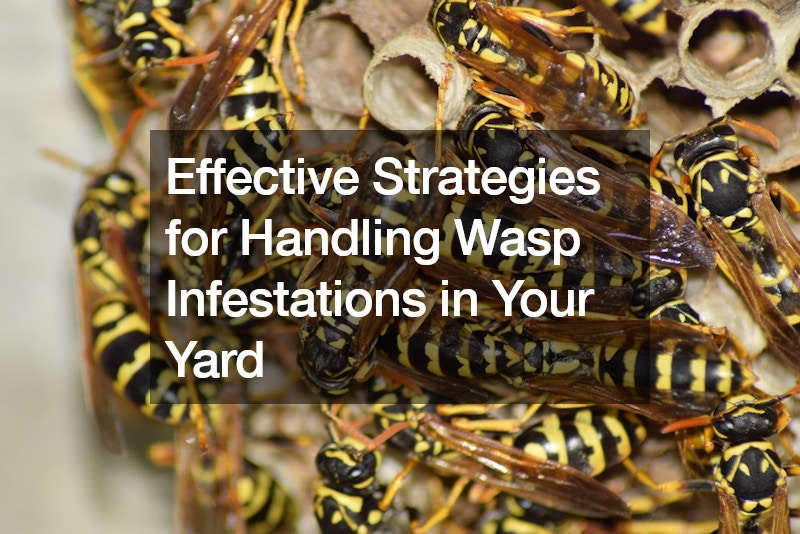
Wasps buzzing around your yard can quickly turn a pleasant outdoor experience into a nightmare. These pesky insects not only disrupt outdoor activities but also pose a threat with their painful stings. However, with the right knowledge and strategies, you can effectively manage and eliminate wasp infestations from your yard. Here are some practical tips to help you handle these unwelcome visitors.
Identifying the Enemy
Before you can effectively deal with a wasp infestation, it’s crucial to accurately identify these insects. Unlike bees, wasps have a distinct appearance characterized by a pinched waistline and minimal hair.
Additionally, their nests are constructed from a brownish-gray papery substance, making them easy to distinguish. Once you’ve identified the presence of wasps in your yard, it’s time to take action.
Understanding Wasp Behavior
To effectively manage a wasp infestation, it’s essential to understand the behavior of these insects. Wasps are territorial creatures that will aggressively defend their nests if threatened. Therefore, it’s important to approach nest removal with caution and to avoid provoking the insects unnecessarily. Additionally, knowing the peak activity periods for wasps can help you plan outdoor activities accordingly and minimize the risk of encounters.
Getting Rid of Wasps
When it comes to eliminating wasp colonies, there are several effective methods to consider. Traps and sprays are among the most popular options for dealing with these pests. Traps can be baited with sugar water or juice, or you can opt for pre-packaged attractants. Strategically placing traps downwind of outdoor living areas can help capture wasps before they become a nuisance.
For a more immediate solution, sprays offer quick and easy extermination from a safe distance. Whether targeting individual wasps or entire colonies, specialized sprays can effectively eliminate these insects with minimal effort. However, it’s important to exercise caution and follow safety guidelines when using chemical sprays to avoid potential harm to yourself or the environment.
Another option for addressing wasp infestations is to remove the nests yourself. While this approach may be suitable for smaller nests in accessible locations, larger or hard-to-reach nests should be left to the professionals. An experienced exterminator can safely and efficiently remove the nest, reducing the risk of stings and ensuring thorough eradication of the colony.
Contacting a Professional
When dealing with particularly large or inaccessible wasp nests, it’s best to seek the assistance of a professional exterminator. These trained professionals have the knowledge, experience, and equipment necessary to handle even the most challenging infestations safely. By entrusting the task to an exterminator, you can avoid the risks associated with DIY nest removal and ensure a swift and effective solution to your wasp problem.
Mitigating Risks
Having a wasp nest in close proximity to your home significantly increases the risk of getting stung, which can lead to allergic reactions and other health complications. To minimize these risks, it’s essential to take precautions when outdoors, especially during peak wasp activity periods. Wearing long sleeves, pants, and closed-toe shoes can provide added protection against stings, while avoiding sudden movements and disturbances near nests can help prevent aggressive behavior from wasps.
In the event that you are stung by a wasp, it’s important to know how to respond promptly. Wash the affected area with soap and cold water to remove any venom and reduce the risk of infection. Applying an antihistamine can help alleviate swelling and discomfort, while calamine lotion can soothe itching and irritation. If you experience severe symptoms or signs of an allergic reaction, seek medical attention immediately.
Preventing Future Infestations
Once you’ve successfully eliminated a wasp infestation from your yard, it’s important to take steps to prevent future occurrences. Regular inspection of your property for signs of new nests can help you catch potential infestations early and address them before they become a problem. Additionally, sealing potential entry points such as cracks and gaps in walls and windows can help prevent wasps from gaining access to your home.
Environmental Considerations
When addressing wasp infestations, it’s essential to consider the environmental impact of your chosen extermination methods. Opting for eco-friendly traps and sprays can help minimize harm to beneficial insects and the surrounding ecosystem. Additionally, proper disposal of nest remnants and chemical products can prevent contamination of soil and water sources.
Educating Others
Sharing your knowledge and experiences with friends, family, and neighbors can help raise awareness about the importance of wasp control and prevention. By educating others about effective strategies for handling infestations and promoting responsible extermination practices, you can contribute to creating safer and more enjoyable outdoor environments for everyone.
Conclusion
Dealing with a wasp infestation in your yard can be a daunting task, but with the right strategies and precautions, you can effectively manage and eliminate these pests. By accurately identifying wasps, understanding their behavior, employing appropriate extermination methods, and taking proactive measures to prevent future infestations, you can reclaim your outdoor space and enjoy a wasp-free environment. Remember to prioritize safety, environmental responsibility, and community education at all times to achieve long-term success in managing wasp populations.
.






